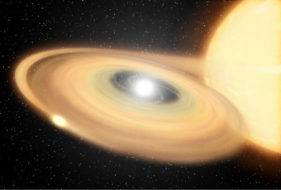A peculiar white dwarf could be what’s left after a failed supernova explosion.

NASA / JPL-Caltech
A recently found white dwarf — the burnt leftover of a star like our Sun — could be the remnant of a failed Type Ia supernova explosion.
One of the characteristics that make Type Ia supernovae interesting for science — apart from the fact that they are exploding stars whose death flashes shine 5 billion times brighter than our Sun — is that they all have the same intrinsic brightness. That means that they act like reference points scattered around the universe for astronomers, who can use them to measure distances. Once one of them pops up in a far-away galaxy, an observer can just measure how bright the exploding star appears to be and determine how distant the supernova — and its host galaxy — must be for it to look that faint.
The reason these events’ brightnesses are so reliable is because they are all created when a white dwarf steals too much material from a companion star. When the white dwarf reaches 1.4 solar masses (a point called the Chandrasekhar limit) its internal pressure causes a nuclear chain reaction that destroys the white dwarf.
Or maybe not. Recent findings show that Type Ia supernovae do not always happen in such clockwork fashion. Sometimes things get messed up along the way and the explosion does not completely obliterate the white dwarf, resulting in subluminous supernovae. Astronomers think these failed detonations lie behind a subclass called Type Iax — with 53 known objects at a recent count — that show lower luminosities, lower ejecta velocities, and more variable characteristics than normal Type Ia supernovae.
In an article published August 18th in Science, an international group of astronomers describes an object called LP 40-365 that, they think, might be the remnant of a white dwarf after one of these explosions.
LP 40-365 is a tiny star: The team estimates that it has only 0.14 solar mass and is a mere 8% as wide as the Sun, or about 8½ times larger than Earth. Spectral analysis shows an absence of hydrogen, helium, and carbon on its surface. This could be consistent with a white dwarf that expelled what was left of the star’s outer layers of hydrogen and helium into space in a subluminous supernova. The carbon could have been converted into heavier elements, or maybe sank deep inside the core.
This partially detonated, burnt cadaver of a Sun-like star is also travelling at a speed greater than the escape velocity of the Milky Way, a speed best explained by a powerful explosion that gave it a mighty kick, the authors suggest.
“There are other ways to propel a star at a very high velocity, such as an encounter with the galactic center or dynamical instabilities in a triple system, but neither could explain the strange surface of this object,” said principal author Stephane Vennes (Czech Academy of Sciences). “It is extremely difficult to peel off [the outer layers of] a dense, compact white dwarf unless a vast amount of energy is invested. The thermonuclear explosion of a white dwarf star does just that.”
Ryan Foley (University of California, Santa Cruz), an astronomer familiar with Iax supernovae who was not involved in this study, is puzzled by the absence of carbon in the star’s surface. But he considers the new observations consistent with the SN Iax scenario, where a white dwarf explodes but not as strongly as in a Type Ia supernova. “We think that in at least some cases the white dwarf doesn’t get completely disrupted and there is a gravitationally bound, battered and bruised star left behind,” Foley said. “We call these ‘zombie stars’ since they died in the explosion, but keep on ‘living.’”
According to Foley, there could be many zombie stars in the Milky Way, with an expected rate of creation of one about every 300 to 1,000 years. “If this is one, it could help us start to understand this new population of objects in our galaxy,” Foley said.
The new study also adds to a long-standing debate about the origin of Type Ia supernovae. There are two main accepted scenarios to produce one of these mighty explosions. In one of them, called the single-degenerate model, the white dwarf siphons gas form an ordinary star companion until it reaches the Chandrasekhar limit. In the second model, called the double-degenerate model, two white dwarfs merge, reaching an unstable mass that triggers the explosion.
According to Vennes, the finding of this putative supernova remnant is only consistent with the single-degenerate model. “The merger of two white dwarfs and subsequent explosion cannot leave any left-over. All the matter is consumed,” he said. A single-degenerate situation, however, should sometimes leave a remnant with properties similar to that of the white dwarf LP 40-365.
References:
S. Vennes et al. “An unusual white dwarf star may be a surviving remnant of a subluminous Type Ia supernova.” Science. August 2017.
S. Jha. “Type Iax Supernovae.” Handbook of Supernovae. July 2017.
 0
0









Comments
You must be logged in to post a comment.